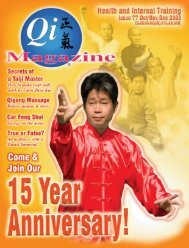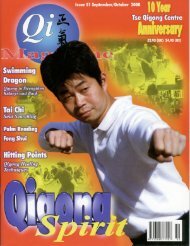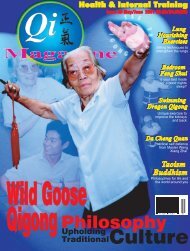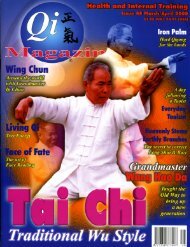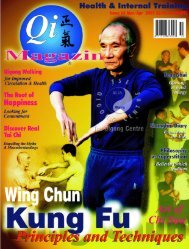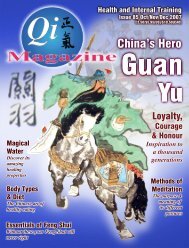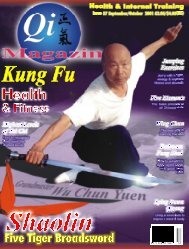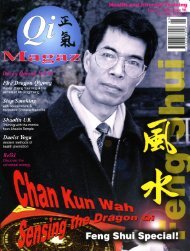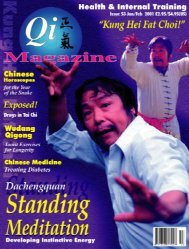Issue 49 - Tse Qigong Centre
Issue 49 - Tse Qigong Centre
Issue 49 - Tse Qigong Centre
- No tags were found...
Create successful ePaper yourself
Turn your PDF publications into a flip-book with our unique Google optimized e-Paper software.
with the knees slightly bent and“grasping” slightly inwards. There shouldbe no tension on the back at all.Sometimes, beginners will find their legstire easily and may even find the musclestrembling. This is normal and all part ofdeveloping your stance and internalenergy. If you find this happening, thenyou should try to sink your weight slightlymore on the thighs as it is easy to try tostraighten the legs when this happens.Often times, Siu Lim Tao can be neglectedas students are so keen to develop theirfighting techniques. However, if your SiuLim Tao is good, then it will be easier foryou to develop your Chi Sau skill in thefuture when you do find a Sifu. Siu LimTao not only develops internal energy, italso makes the mind calm, so that youcan “see” and react to the Chi Sautechniques more clearly.Best wishes, Michael <strong>Tse</strong>EverToo Old?Hello Master <strong>Tse</strong>,I am 17 years old and live inMalaysia. I am Chinese, too. I am veryproud of your Wing Chun guide book:very attractive. Actually I’m training inTaekwondo and have my red black beltwhich means the highest belt. I want totrain in Wing Chun because this form ofmartial arts is very powerful, especially thefist. Hopefully, Sifu can explain moreabout the training and the ranking. I amvery interested in Wing Chun. I have aquestion to you, Sifu, am I too old to trainin this Wing Chun? Can I catch up in thisWing Chun skill in this period of time?Bad <strong>Qigong</strong>Dear Sir,I am writing to ask for some information on <strong>Qigong</strong> exercises. I have beenpractising Tai Chi for four years and enjoy every minute of it. Our class routineconsists of a <strong>Qigong</strong> exercise routine, followed by the Yang style short form.Having read several books, (<strong>Qigong</strong> for Health & Vitality being the latest), Ihave experienced both the physical and mental effects over this period, and I am ofthe opinion that the whole thing is good for you. I have heard, however, that someinstructors do not teach <strong>Qigong</strong> because they believe it to be harmful. Also, I havenoticed on three occasions (over this four year period) that a person has felt faint -possibly a lowering of blood pressure?Can you give me any information on this? Is there evidence to show that<strong>Qigong</strong> is “bad” for some people. Do you recommend any exercises that wouldcounteract this feeling? I am sure you are extremely busy in your work but wouldappreciate it greatly if you could answer my questions or perhaps point me in theright direction. Thank you in anticipation.Yours faithfully, GCDear GC,There are many, many <strong>Qigong</strong> styles and there are even more <strong>Qigong</strong>instructors. However, for both of these, time proves everything. If a skill has beenpassed down for many generations and those who have studied it have had goodresults, ie. good health and longevity, then we would consider this to be a safe andhealthy <strong>Qigong</strong> style. However, sometimes, it is not the style of <strong>Qigong</strong> that is atfault for causing problems but the instructor. Sometimes they have not been qualifiedto teach and therefore they may not understand fully the principles of the skill. Inaddition, if an instructor does not have much experience, they may not know howto handle such a case as you mentioned, where a student felt faint.People who come to study <strong>Qigong</strong> are of varying levels. Some are young,some are old. Some are quite healthy while others may be quite ill. If someone hashigh blood pressure, for instance, then postures where they have to bend over orsquat in a low position may be very difficult and cause them to feel faint. In this thecase, the instructor should show them the way in which to do the movement withoutcausing more problems. Another person may have a back injury which causesthem great pain and so they should take it easy until they become more flexible.Each student is different.It is for this reason that I am very strict for persons not teaching the skill thatI have taught them until they have been properly qualified as my instructor. If theyteach without permission and cause someone problems, then it reflects badly notonly on them but on myself and my teacher, Grandmaster Yang Meijun. So justlike we are careful of the food we buy in the super market, making sure it is freshand safe, we should also make sure that the <strong>Qigong</strong> we study is proper and theinstructor has been qualified to teach and that they understand the skill which theyare passing on to their students.Yours sincerely, Michael <strong>Tse</strong>Hopefully, Sifu could answer my specificquestion. I hope I can hear good newsfrom you.See you in the future.CK, MalaysiaDear CK,Thank you for your letter. Actually,any good martial art, you should be ableto practise at any age. My Sifu is nearing80 years old now and is still very healthyand strong. You should not, however, bein a hurry to “catch up”. A martial artshould be a life journey which iscontinually developing, exploring andlearning to understand. With each levelyou progress to, you will see somethingcompletely new or come to understandsomething on a different level. The mostimportant thing is to keep practising andin the proper way.Best wishes,Qi Magazine 5



